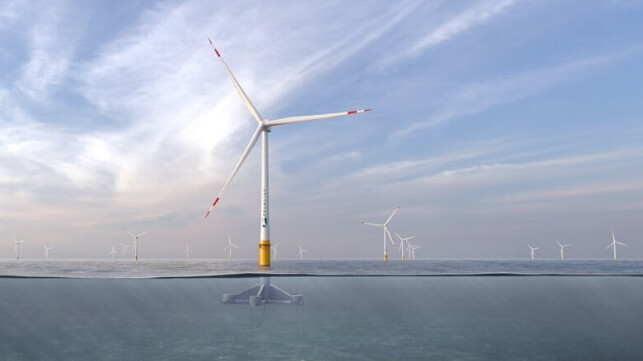US Competition Selects Finalists in Floating Offshore Wind Technologies

The U.S. Department of Energy selected the finalists in its ongoing competition to promote the development and commercialization of technologies for floating offshore wind energy. It is part of a broader government initiative designed to accelerate floating offshore wind installations.
The government believes that floating offshore wind has the potential to provide massive amounts of renewable energy but to achieve that new technologies and manufacturing will be required to make the manufacturing and installation of floating turbines more economical and efficient. U.S. studies suggest that floating turbines could produce 2.8 terawatts of electricity in the United States alone, which would be more than double current U.S. electricity consumption. About two-thirds of the U.S.’s offshore wind power potential is in waters that are more practical and cost-effective for floating versus fixed-bottom turbines. The Biden administration set a goal of deploying 15 gigawatts of floating offshore wind capacity by 2035.
Floating offshore wind structures may be one of the biggest challenges in the clean energy transition. Exports highlight that the structures could be the largest man-made structures ever built. They will have to be able to float and maintain their operations in high-wind areas of the ocean that are too deep for today’s fixed-bottom offshore wind turbines.
The FLOWIN (American-Made FLoating Offshore Wind ReadINess) competition was launched to bring together the design, manufacture, supply chain, and transportation components required to deploy floating wind turbines. It is a three-phase competition with nine Phase One winners announced in March 2023.
In the just completed Phase Two those companies were challenged to adapt their designs for production. They were challenged to develop plans for mass production, assembly, and deployment. They were also required to submit a cost estimate and production throughput analysis. The competition is being administered by the National Renewable Energy Laborites (NREL). Each of the five Phase Two winners was awarded $450,000 in cash and $100,000 in credit for technology support at a Department of Energy national laboratory. The full FLOWIN competition has a total cash pool of $5.85 million, plus up to $1.175 million in vouchers for technical support from DOE national laboratories.
PelaStar, Glosten’s lightweight tension-leg platform technology, was one of the winners of Phase Two. The PelaStar partnership, which includes Everett Floating Structures, FibreMax, Avient-Dyneema, GMC Limited, Triton Anchor, Havfram, Foss Offshore Wind, Geodis, TRC, and Pacific Northwest National Laboratory, presented an aggressive deployment plan. They proposed an approach to assemble and install one 15MW floating wind turbine every week starting in the early 2030s.
Other finalists include FloatHOME’s triangular platform, WindFloat. Developed with supporters including Principle Power and Aker Solutions, it is its fourth generation with a design that provides deep-water stability with features including a damping system to absorb wave excitation movement.
Technip Energies’ INO15 design is a semisubmersible, three-column floating platform. This design can be assembled at ports at a low cost and is robust enough to withstand harsh operating environments. The Tetra Triple-One floating platform uses a building-block arrangement, which involves fully producing the parts needed in an industrialized manufacturing environment and then transporting them to the assembly site. This makes portside construction possible for a range of platform configurations, turbine sizes, and site conditions.
Finally, the concept from WHEEL U.S. incorporates tanks for buoyancy and balance, and can temporarily act as a barge platform, allowing it to be assembled with the wind turbine near shore and towed to sea.
These teams will now move on to the final prize phase, during which they will complete location-specific implementation pathways for domestic manufacture and deployment of their floating offshore wind energy technologies. Up to three winners from Phase Three will each receive a $900,000 cash prize.
This is also part of the broader Biden Administration interdepartmental effort involving Energy (DOE), Interior, Commerce, and Transportation to drive U.S. leadership in the design, deployment, and manufacturing of floating wind technologies. Since the initiative's launch in September 2022, the U.S. has dedicated over $950 million in planning, leasing actions, research, development, demonstration, deployment, and more in an effort to realize the full potential of this renewable power source.
About two-thirds of the country's offshore wind potential is in waters that are deep enough to make floating offshore wind turbines more practical and cost-effective than fixed-bottom turbines. Efforts have focused on floating turbine designs, advances in planning for the transmission of power from floating offshore wind projects, and investments into the first offshore wind terminal on the Pacific Coast.
Last month, DOE announced its intent to issue $20 million in funding for projects that improve floating offshore wind systems through refinement and innovation in floating platform design, manufacturing, deployment, and integrated turbine/platform research. The funding opportunity will also offer $3.5 million for the establishment of a floating offshore wind Center of Excellence.
The first floating offshore wind installations in the United States are expected to include the leases auctioned in 2023 off California. The Bureau of Ocean Energy Management also recently proposed ten new lease areas, two in Oregon and eight in the Gulf of Maine, which are likely to all be dependent on floating turbines.
